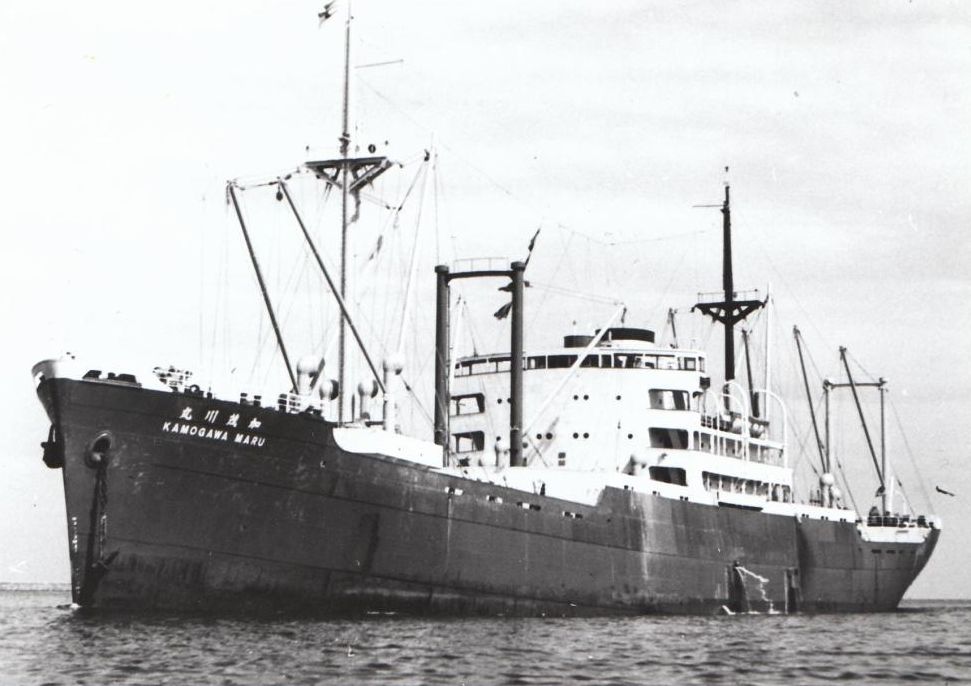KOKUKI-UNPANSEN!

|
(KAMOGAWA MARU prewar)
IJN KAMOGAWA MARU:
Tabular Record of Movement
© 2007-2010 Bob Hackett, Sander Kingsepp and Peter Cundall.
Revision 1
26 August 1937:
Nagasaki. Laid down at Mitsubishi Heavy Industries' shipyard for Toyo Kaiun K. K.
16 February 1938:
Launched and named KAMOGAWA MARU.
15 April 1938:
Completed.
April 1940:
Chartered by Mitsui Bussan. Steams from Shisui, Korea to Iran. [1]
28 May 1940:
Steams from Kobe to Rangoon (now Yangon), Burma (now Myanmar), Madras, India and Iran and return.
29 September 1940:
Steams from Japan to Bombay and Karachi, India (now in Pakistan) and return. Later, repeats the voyage.
5 September 1941:
Requisitioned by the IJN. Begins conversion to an armed auxiliary aircraft transport. 4.7-inch guns are installed at the bow and the stern. Registered in the IJN. Recalled Captain (Ret) Shimizu Iwao (39)(former CO of ABUKUMA) is the CO.
15 October 1941:
The conversion is completed.
8 December 1941: Opening of Hostilities with the Western Allies:
Takao, Formosa. KAMOGAWA MARU is attached to Vice Admiral (later Admiral) Tsukahara Nishizo’s 11th Air Fleet.
11-12 December 1941: Operation "M" - The Attack on the Southern Philippines:
Rear Admiral (later Vice Admiral) Kubo Kyuji's (former CO of SUZUYA) Fourth Surprise Attack Unit's seven troop transports land troops at Legaspi, Luzon, Philippines covered by light cruiser NAGARA and DesDiv 24's four destroyers. Seaplane tenders CHITOSE and MIZUHO provide air cover.
13 December 1941:
KAMOGAWA MARU departs Takao for Legaspi on an aircraft transport run escorted by destroyer AKIKAZE.
23 December 1941:
Arrives back at Takao.
25 December 1941:
Departs Takao.
28 December 1941:
E of Luzon. KAMOGAWA MARU is damaged by marine casualty. [2]
3 January 1942:
Arrives at Davao, Philippines where forces are being assembled for the invasions of the Netherlands East Indies.
6 January 1942:
Arrives at Legaspi.
E 18 January 1942:
Departs Legaspi for Tarakan, Borneo.
23 January 1942:
The Balikpapan Invasion Force convoy carrying the Sakaguchi Detachment (56th Regimental Group) departs Tarakan consisting of Army transports KURETAKE, HAVANA, EHIME, LIVERPOOL, TEIRYU, HITERU, TSURUGU, HANKOW and NISSHO MARUs and Navy transports KANAYAMASAN, TATSUGAMI, NANA, SUMANOURA, KUMAGAWA, TOEI, ASASHISAN and NITTEI MARUs.
That same day, after the Balikpapan Invasion Force departs, KAMOGAWA MARU arrives from Legaspi and anchors at Tarakan. She probably delivers Mitsubishi A6M "Zeke" fighter aircraft, personnel and munitions to the Tainan Naval Air Group based there.
3 February 1942:
Arrives at Balikpapan, Borneo. She probably delivers fighter aircraft, personnel and munitions to the Tainan Naval Air Group that recently arrived from Tarakan.
28 February 1942:
Departs Balikpapan for Surabaya, Java.
1 March 1942:
Departs Surabaya for Bali carrying troops, supplies and probably A6M fighters and munitions to elements of the 3rd and Tainan Naval Air Groups at Denpasar airfield.
2 March 1942:
Off Sumbawa Island, Java. At night, N of Lombok Strait, lookouts on LtCdr (later Captain) Richard G. Voge’s USS SAILFISH (SS-192) sight a large ship on a southwesterly course. Voge submerges to periscope depth. As the range closes, he also spots three escorts, but misidentifies the large ship as fleet carrier KAGA known to be operating S of Java. Voge submerges to periscope depth and sets up. He sets up, choosing a long range attack from outside of the screen of escorts.
At 2059, Voge fires four torpedoes at the large ship from over 4000 yards away. A torpedo hits KAMOGAWA MARU port side just below the bridge. Flames shoot up to about 150 feet. KAMOGAWA MARU goes dead in the water and sinks in five minutes N of Lombok Island near the approach to Lombok Strait at 08-06S, 115-57E. The escorts counter-attack, dropping 40 depth charges, but Voge evades with little damage to SAILFISH.
Captain Shimizu is KIA. He is promoted Rear Admiral, posthumously. Five sailors, 273 soldiers and 48 passengers are also lost.
15 March 1942:
Removed from the Navy List.
Authors’ Notes:
[1] KAMOGAWA MARU remained under charter to Mitsui Bussan until requisitioned.
[2] As used in U. S. Federal Regulations, the term "marine casualty" includes groundings, collisions, strandings, founderings, heavy weather damage, fires, explosions, failure of gear and equipment and any other damage which might affect or impair the seaworthiness of the vessel.
- Bob Hackett, Sander Kingsepp and Peter Cundall.
Back to
Aircraft Transports Page





